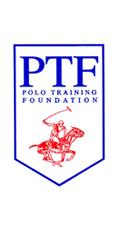Within the Argentine polo community, a new star has been born— not on the polo field, however, but along the sidelines where he takes
photographs to inspire the painter’s art.
To interview 34-year old Esteban
Diaz Mathé as he talks about himself
(in his second language, English), time
and again he conjures up not so much a
life story as the plot of a romantic
novel.
Let us go back to the beginning, to
the dawn of the 19th century. As he tells
it, his forebears—poor but determined to
prosper—migrated from Spain to
Argentina to begin a modest business.
The business soon flourished so that
their descendants began marrying into
a landed family. Eventually they
acquired their own estancia near the
town of Lincoln, some 200 miles
northwest of Buenos Aires. As Esteban
tells it, spans thousands of hectares
supporting thousands of cattle.
“I had a privileged upbringing
because I was born into a family
which could offer us so many
opportunities,” he explains. He was
educated in Buenos Aires as were his
three elder brothers each of whom now
pays his way in an occupation of his own
choice, whether engineering, banking
or the economy.
Born and raised in Buenos Aires,
Esteban matriculated into the
University Del Salvador from where he
graduated in psychology. “Then I
switched to architecture and joined a
firm where I specialized in human
resources. As a hobby I started drawing
and discovered my gift for art. From
drawing with a pen I went to charcoal
and then to paint and I copied prints of
the great masters, Michelangelo, de
Vinci, Caravaggio, Rembrandt and the
Spanish painter Joaquin Sarolla.’’
(1863-1923, famous for his landscapes
and portraits.)
“The Buenos Aires art community
encouraged me to become an artist. I
had my doubts but people were buying
my paintings, so I gave up architecture
to become a traveling artist. I began on
the family estancia. As a child I had
returned there for three months every
summer. I enjoyed the hunting and the
fly-fishing in Patagonia but my first love was the gauchos and their horses. To me
they were a dream. They were my
friends and my father-figures. At dawn
each morning they would call for me
with a horse and I would ride with them
all day. They’re still my friends, though
many have since retired.’’
And the gauchos? In their affinity for
horses, cattle and wide open spaces,
they are coupled with North American
cowboys but there the similarity ends.
Where Hollywood arms Wild West
cowboy with “six-shooters,’’ the
gauchos’ chosen weapon was el facon, a
long-bladed sharp-edged knife for
fighting and for any other purpose.
As to their genesis in the 17th
century they were the offspring of
Spanish colonizers and indigenous
Indian women, a subject people, viewed
by their colonial masters as layabouts
and trouble-makers albeit over time
increasingly admired for their skill with
horses and cattle. Estancias have now
long been fenced but their patrons
(owners) still employ gauchos to manage
their cattle, though with their nomadic
instincts now in check. In Argentina’s
intermittent wars throughout the 19th
century to end Spanish imperial rule,
the role of gauchos in Argentine cavalry
won the admiration of their homeland,
now celebrated annually in rodeos and
cultural festivals, a legacy to which
Esteban Diaz Mathé is clearly in thrall.
Seven years ago he widened his vision
to Argentina as a whole, hosted by
estancia patrons, some 40 in all, in 10 of
Argentina’s 23 provinces. The many
photographs he took as he explored his
homeland were never meant to be
copied as paintings. They were intended
in their variety to offer suggestions in
their light and color and the facial
expressions of gauchos and their
horses, adding or deleting photographic
details, to enhance his artworks, a
practise he continues.
Together with a bilingual text written
by Mariano Fernandez, a freelance
pastoral journalist (otherwise
contributing to livestock pastoral
magazines the world over), in 2012
Esteban published his first book of
artworks, “Ser Argentino” (Being
Argentine). As the cover-flap tells us,
“Gathering information, investigating
and sharing his daily work with rural
people, Esteban Mathé seeks to capture
through his paintings the very essence of
the national being.’’ To promote
Argentina to the world, the Ministry of
Foreign Affairs distributed copies of “Ser Argentino” to its 80 its embassies worldwide.
A further 3,000 copies were sold to
Buenos Aires banks and business houses.
Esteban freely acknowledges that the
credit due for his success goes to his
wife Florencia, a lawyer by profession,
whom he met by chance during his first
journey across Argentina. “She is the
love of my life,” he declares. “She
supported me 100 percent. When you
dream of something outside the box you
really must feel you can do it. We
married four years ago and we now have
a son, Lorenzo. He’s 18 months old and
a bit of a demon. He is not allowed in
my studios because he might break it to
pieces.’’
Esteban also impressed as the very
antithesis of a self-employed artist. “I
am very methodical,’’ he explained.
“After breakfast with my wife and son I
leave home for my studio, which is in
another part of the city, and there I
work a 10-hour day and return for
dinner at our home, which is in
Recoleta. If my studio was in our home
I could be tempted to return to it at 3
o’clock in the morning to change
something I’d painted the day before.
But to be truly creative you must also let
yourself go and put your work aside
until you find your breath again.”
In the opening pages of “Ser
Argentino” Esteban expressed his
gratitude to individuals and institutions
“... thanks to the extraordinary
contribution of the photographic
archive of El Grafico magazine. Almost
90 years old, El Grafico has always been
close to Argentina polo and this edition
is full proof of this. We thank the
Argentine Polo Association, La Nacion
newspaper and Mrs Luisa Miguens de
Tanoira for their co-operation in the
making of this work.’’ Anyone wanting
to view other Esteban artworks should
visit his website, diazmathé.com
confirming that he is in no way a
shrinking violet.
But what prompted him to add polo to
the homage he paid to gauchos and their
horses? Thanks to “Ser Argentino,” he
came to the attention of Marcos Uranga,
a former president of the Argentine Polo
Association and a founder and first
president of the Federation of
International Polo now representing 56
national polo associations. Seventy-nine
years old with seven children and 21
grandchildren, he is now a sort of elderstatesman
of global polo. He contacted
Esteban, expressed his admiration for the
painter’s equine artworks and urged him
turn his talent to celebrating polo.
“Though I’ve loved horses and riding
all my life I only played ‘fun’ polo as a
kid with a friend whose family owned a
horse-stud outside Buenos Aires,’’
Esteban recalls. “But two years ago with
Marcos’s encouragement I started
watching polo and taking photos at all
the important polo clubs like
Hurlingham, Tortugas and Palermo. At
Marcos’s request I also did polo
drawings for the official history of FIP
(commemorating its 30th anniversary),
and I’ve painted the front-covers of the
last four annual editions of the
Argentine Polo Pony Breeders’
Association.’’ With Marcos’s support he
has now struck up friendships and won
the support of such eminent polo
families as Pieres, Mac Donough and
Novillo-Astrada.
Beyond Argentina, Esteban has drawn
and painted the Brazilian landscape,
estancias and its polo. Armed with his
paints, brushes and cameras, he recently
viewed American polo for the first time
as a guest of ‘Skey’ Johnson, father to
Gillian Johnston, patron of the U.S. highgoal
Coca-Cola team based in Wellington,
Florida, at Johnson’s own Flying H Polo
Club in Big Horn, Wyoming.
Postscript: Henry Ward Beecher
(1815-87) was an American evangelical
preacher celebrated in his time for the
eloquence and moral fervour of his
sermons. Now he is recalled only as the
brother of Harriet Beecher Stowe,
author of “Uncle Tom’s Cabin,”
(published in 1851).
Brother and sister were fervently
committed to the abolition of slavery, a
conviction they share with Abraham
Lincoln who, elected to the presidency,
sent Beecher to Europe to explain the
President’s cause to the wider world.
Beecher features here because he once
famously remarked of an artist’s role in
society as if he was speaking of Esteban
Diaz Mathé: Every artist dips his brush
in his own soul and paints his own nature into his pictures.
By Chris Ashton
|









